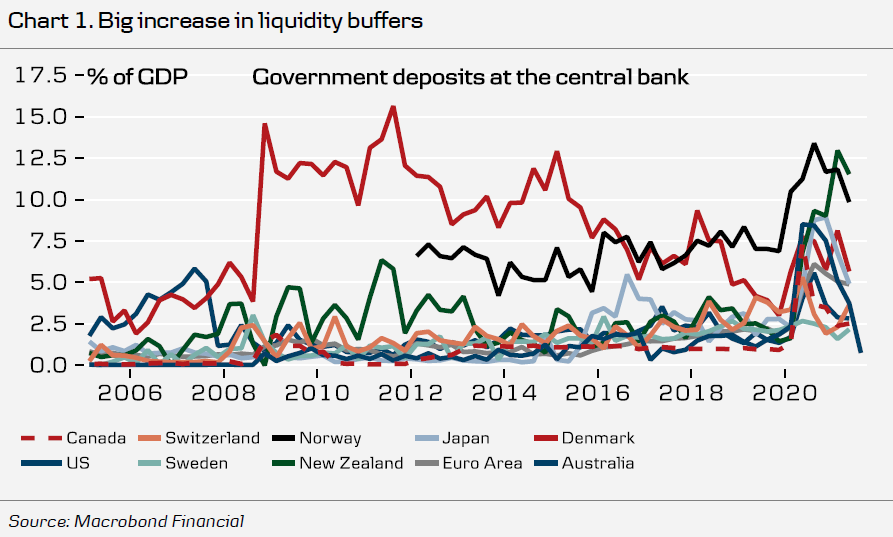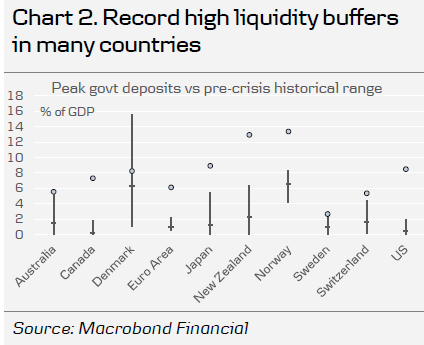-
In the second paper in our series on different cross-country monetary aspects of the COVID crisis, we look at the role of government liquidity management.
-
When the crisis hit last year, debt management offices build large liquidity buffers on deposit accounts amounting to around 6-13% of GDP.
-
Quantitative easing no longer is just about supporting bank liquidity. Now it is also about supporting public liquidity.
-
This is the second paper in a series, which looks at different cross-country monetary aspects of the crisis. In the first paper Research Global: COVID monetary policy: fast easers to tighten first, we look at the central bank response.
Surge in government’s liquidity buffers
In the second paper our series, which looks at different cross-country monetary aspects of the COVID crisis, we turn to the role of government liquidity management. When the crisis hit last year, debt management offices build large liquidity buffers on deposit accounts (see chart 1).
Most governments in G10 hold a deposit account with the central bank – Sweden is an exception. Government deposits are ready available liquidity to spend on the budget. In most cases liquidity buffers amounted to around 6-13% of GDP, which meant governments had raised enough funds to cover all or most of the deficit resulting from the crisis.
The level of liquidity buffers before the crisis varied between countries. Denmark operated with a large buffer during the financial crisis and the European debt crisis, while the Euro Area, Japan and the US historically have held small buffers. In all countries, except for Denmark, liquidity buffers grew to record high levels during the crisis (see chart 2).
This publication has been prepared by Danske Bank for information purposes only. It is not an offer or solicitation of any offer to purchase or sell any financial instrument. Whilst reasonable care has been taken to ensure that its contents are not untrue or misleading, no representation is made as to its accuracy or completeness and no liability is accepted for any loss arising from reliance on it. Danske Bank, its affiliates or staff, may perform services for, solicit business from, hold long or short positions in, or otherwise be interested in the investments (including derivatives), of any issuer mentioned herein. Danske Bank's research analysts are not permitted to invest in securities under coverage in their research sector.
This publication is not intended for private customers in the UK or any person in the US. Danske Bank A/S is regulated by the FSA for the conduct of designated investment business in the UK and is a member of the London Stock Exchange.
Copyright () Danske Bank A/S. All rights reserved. This publication is protected by copyright and may not be reproduced in whole or in part without permission.
Recommended Content
Editors’ Picks
EUR/USD rises toward 1.0700 after Germany and EU PMI data

EUR/USD gains traction and rises toward 1.0700 in the European session on Monday. HCOB Composite PMI data from Germany and the Eurozone came in better than expected, providing a boost to the Euro. Focus shifts US PMI readings.
GBP/USD holds above 1.2350 after UK PMIs

GBP/USD clings to modest daily gains above 1.2350 in the European session on Tuesday. The data from the UK showed that the private sector continued to grow at an accelerating pace in April, helping Pound Sterling gather strength.
Gold price flirts with $2,300 amid receding safe-haven demand, reduced Fed rate cut bets

Gold price (XAU/USD) remains under heavy selling pressure for the second straight day on Tuesday and languishes near its lowest level in over two weeks, around the $2,300 mark heading into the European session.
Here’s why Ondo price hit new ATH amid bearish market outlook Premium

Ondo price shows no signs of slowing down after setting up an all-time high (ATH) at $1.05 on March 31. This development is likely to be followed by a correction and ATH but not necessarily in that order.
US S&P Global PMIs Preview: Economic expansion set to keep momentum in April

S&P Global Manufacturing PMI and Services PMI are both expected to come in at 52 in April’s flash estimate, highlighting an ongoing expansion in the private sector’s economic activity.

